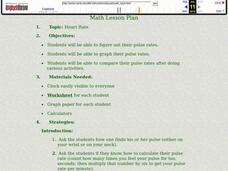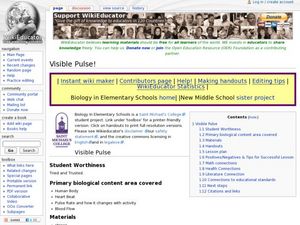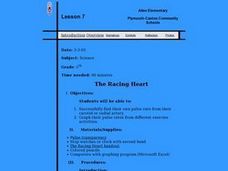Baylor College
Heart and Lungs
With a partner, youngsters measure their pulse and breathing rates, both at rest and after running in place for a minute. While this activity is not novel, the lesson plan includes a large-scale classroom graphing activity and other...
Baylor College
Heart Rate and Exercise
What is the relationship among the heart, circulation, and exercise? Your class members will explore first-hand how different physical exercises affect an individual's heart rate. They will begin by learning how to measure their own...
Curated OER
Keeping Your Heart in Good Shape: What are the Benefits? - Biology Teaching Thesis
Learners name the main parts of the heart and what events occur there. They write a reaction that contains complete sentences, and uses proper spelling and grammar, after viewing a video. Students define the following terms: contraction,...
Curated OER
Comparing Pulse Rates
Young scholars participate in a lab that demonstrate one example of how the human body maintains homeostasis. Students collect data from themselves and observe how their own bodies react to exercise.
Curated OER
The Effect of Math Anxiety on Cardiovascular Homeostasis
Using a pulse monitor, learners will measure a resting pulse, take a math test, and then measure the pulse again. They analyze the change in pulse and compare it to performance on the test. This multi-purpose lesson can be used in a...
Curated OER
Cardiac Hill
Learners calculate pulse rates to determine level of exertion. In this human body lesson, students hike up a hill or steep slope and take their pulse. Learners observe their breathing and energy level then record data.
Curated OER
Graphing Heart Rates
Students take their pulse rates. In this graphing lesson, students take their pulse rates and graph them. Students do various physical activities and graph the differences in their pulse rates.
Curated OER
Cardiorespiratory Fitness
Students explore cardiorespiratory fitness. In this biology lesson plan, students gain an understanding of pulse rates in order to compare lung capacities of active and inactive males and females. They also learn how to take and compare...
Curated OER
How Hard Does Your Heart Beat?
Students explore how intensity of activity increase heart rate. They are first instructed to check their pulse rate while lying down for approximately 2 minutes in a restful position. They record their heart rate on a worksheet provided...
Curated OER
Visible Pulse
Students record their pulse rate. In this circulatory system lesson, students use a piece of clay and a straw to make their pulse move visible and easier to accurately count and record.
Curated OER
Keeping Healthy
In this pulse rate worksheet, students look at the six pictures of the girl sleeping, jogging, reading, walking fast, sprinting, and walking slowly. Students then write the one of the pulse rates for each picture.
Curated OER
Circulation
In this circulatory system activity, students design an experiment to test the circulation of six of their friends. They select and exercise to increase circulation, take pulse and blood pressure readings from each person before and...
Curated OER
Changes in Pulse Rate
Eighth graders practice making observations and collecting data after determining a baseline pulse rate then collect data on the changes in that rate with exercise. Students must organize their data and analyze their observations.
Curated OER
The Racing Heart
Fifth graders locate their own pulse rate from their carotid or radial artery, and graph their pulse rates after completing various exercise activities. They graph their data on a pie graph using Microsoft Excel software.















